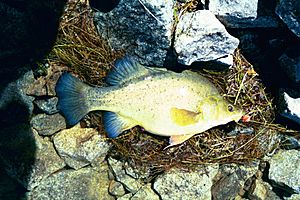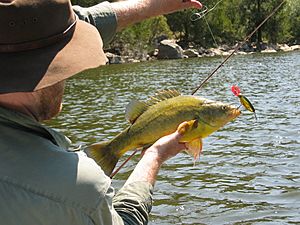Golden perch facts for kids
Quick facts for kids Golden perch |
|
|---|---|
 |
|
| A large, stocked, female golden perch caught from an impoundment: The fishing lure is still in its mouth. | |
| Conservation status | |
| Scientific classification | |
| Synonyms | |
|
The golden perch (Macquaria ambigua) is a cool Australian freshwater fish. It's usually yellow or gold. You'll mostly find it in the Murray-Darling River system. There are also different types (subspecies) in the Lake Eyre-Cooper Creek system and the Fitzroy River in Queensland. Even though it's called a "perch," it's not a true perch. It belongs to a family called Percichthyidae, which are temperate perches. This fish is popular for fishing in Australia. People also call them "goldens," "yellowbelly," or "callop."
Contents
What Does a Golden Perch Look Like?
Golden perch are medium-sized fish. In rivers, they are often about 30–40 cm long and weigh 1–2 kg. Fish living in large man-made lakes (impoundments) can grow much bigger. They can reach up to 15 kg in these places.
Body Shape and Features
Golden perch have a long body that is deep but flattened on the sides. They have a good-sized mouth and small to medium eyes. Their forehead has a clear curve, and there's a distinct "hump" above their head.
Their gill covers have a small, flat spine. This spine is sharp enough to cut a fisherman's finger! The tail fin, soft dorsal fin (on their back), and anal fin (on their belly) are all rounded. The spiny dorsal fin is strong and not too long.
Coloration
The color of golden perch can change. In muddy waters, they might be pale silvery-gold. In very clear waters, they can be deep yellow, gold, or even bronze-black.
Where Do Golden Perch Live?
Golden perch naturally live in the lower parts of the Murray–Darling River system. They also live in areas with gentle slopes and sometimes even in the lower parts of upland rivers. In the Murray–Darling system, you often find them living alongside Murray cod.
Different Populations
Like many native fish in the Murray–Darling, golden perch have moved between river systems. This happened through natural events where rivers connected. You can find golden perch naturally in the Fitzroy–Dawson River in central Queensland. They also live in the Lake Eyre–Cooper Creek drainage system in Central Australia.
The fish has also been successfully introduced to other rivers. These are in the Northern Territory, Queensland, and New South Wales. Attempts to introduce them to Western Australia have not worked.
Unique Subspecies
The populations in the Fitzroy River and Lake Eyre systems are special. They are likely different subspecies or even separate species. This is because they have been isolated from the Murray–Darling fish for a long time. Some scientists think the Fitzroy River population might be the oldest golden perch group.
Reproduction and Life Cycle
In the Murray River, male golden perch usually become ready to breed at 3 years old. They are about 32.5 cm long then. Female golden perch are ready at 4 years old and about 40 cm long. This is important because the minimum size limit for catching them is often less than 40 cm.
Spawning Conditions
Golden perch usually need a spring or summer flood to start spawning. A "fresh" (a temporary rise in river flow) can also encourage them. These floods or freshes help the young fish survive and grow. Even small increases in water flow can be enough for some spawning.
Female golden perch lay many eggs. A female weighing about 2.2 to 2.4 kg can produce half a million eggs at once! Larger fish produce even more. The eggs float in the water and hatch quickly, usually in 24 to 36 hours.
Migration and Longevity
Golden perch are known for traveling very long distances. This often happens before they spawn. Adult fish have been recorded migrating over 1,000 km. This happens when flood conditions allow them to pass over weirs and other man-made barriers. Smaller migrations are also important for young fish to spread out.
Before European settlement, huge groups of golden perch moved freely. They roamed the entire Murray-Darling River system. Now, many dams, weirs, and locks block their path. This has seriously harmed the species. However, some major weirs have been changed to help fish pass through.
Golden perch can live in a wide range of temperatures, from 4 to 37 °C. They can also handle surprisingly salty water for a freshwater fish. They are very long-lived, with some living up to 26 years. This helps them survive in Australia's challenging environment. It means most adults will get to be part of at least one big spawning event. These big events often happen during very wet years and might only occur every 10 or 20 years.
What Do Golden Perch Eat?
Adult golden perch are carnivores. This means they eat other animals. They feed on smaller fish and larger crustaceans. Their diet includes yabbies, shrimp, frogs, and other aquatic invertebrates.
Angling for Golden Perch
Golden perch are a popular fish for anglers. They are known for being "moody," meaning they can be tricky to catch sometimes. People fish for them throughout their range. Good baits include small yabbies and shrimp. Fishermen also use different types of lures that go deep in the water. Many people enjoy catching golden perch for fun.
Conservation Efforts
Wild populations of golden perch have decreased a lot. Some populations in the upper parts of rivers have even disappeared. This is due to dams and weirs. These structures block their migration paths. They also stop natural floods and change water flows. Sometimes, they release unnaturally cold water, which harms the fish. All these things make it hard for golden perch to migrate, spawn, and grow.
Golden perch are listed as "Vulnerable" in Victoria. This means they need special management to protect them. Weirs are a bigger problem than once thought. A study in 2006 showed that about 90% of golden perch larvae die when they pass through certain weirs.
However, golden perch are bred in hatcheries in large numbers. These fish are then released into rivers to help boost populations. There are growing concerns about keeping the genetic diversity of these fish healthy.



